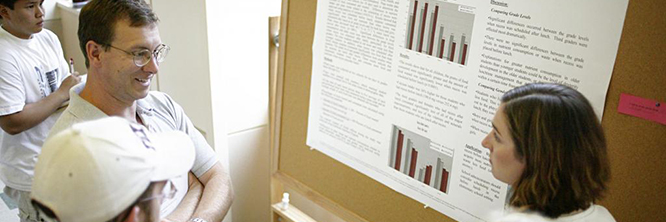Sediment-size distribution and vegetation density on alluvial fans in Umtanum Canyon
Document Type
Poster
Event Website
https://source2022.sched.com/
Start Date
16-5-2022
End Date
16-5-2022
Keywords
alluvial fan, vegetation density, soil sediment size, academic service learning
Abstract
Umtanum Canyon is an east-flowing tributary of the Yakima River Canyon south of Ellensburg, Washington. Alluvial fans have formed along both sides of the canyon at the mouths of small tributaries. We investigated variations in the vegetation density and the sediment size along the alluvial fan gradients. We hypothesized that sediment size would decrease closer to the terminal edge of the fan due to the decreasing energy available to transport larger sediments as distance from the apex increases, while vegetation density would increase due to the presence of finer sediments that allow for greater water retention. We collected data from two alluvial fans on the northern side of the canyon. The alluvial fans were broken into four transects with five 10 m2 plots on each transect and one plot at the apex of each fan. Vegetation density was recorded by dividing each plot into four quadrants and estimating the percentage of sage, shrubs, grasses, and bare ground in each. Sediment samples collected from each plot were sieved into silt, sand, and cobble sizes. The results showed a significant negative correlation between the sediment size and the distance from the top of the alluvial fan transect; however, no significant relationship was found between the percentage of ground covered by plants and the location along the fans. The lack of correlation for vegetation density indicates that sediment size is not the controlling factor, and could be due to the relatively shallow slope of the alluvial fans, allowing for a more even distribution.
Recommended Citation
Badar, Thomas; Brenneman, Daniel; and Lewis, Jennifer, "Sediment-size distribution and vegetation density on alluvial fans in Umtanum Canyon" (2022). Symposium Of University Research and Creative Expression (SOURCE). 15.
https://digitalcommons.cwu.edu/source/2022/COTS/15
Department/Program
Geological Sciences
Additional Mentoring Department
Geological Sciences
Video Presentation
Badar, Thomas SOURCE Presentation Transcript.vtt (20 kB)
Video Captions
Additional Files
Badar, Thomas SOURCE Presentation Video.mp4 (34146 kB)Video Presentation
Badar, Thomas SOURCE Presentation Transcript.vtt (20 kB)
Video Captions
Sediment-size distribution and vegetation density on alluvial fans in Umtanum Canyon
Umtanum Canyon is an east-flowing tributary of the Yakima River Canyon south of Ellensburg, Washington. Alluvial fans have formed along both sides of the canyon at the mouths of small tributaries. We investigated variations in the vegetation density and the sediment size along the alluvial fan gradients. We hypothesized that sediment size would decrease closer to the terminal edge of the fan due to the decreasing energy available to transport larger sediments as distance from the apex increases, while vegetation density would increase due to the presence of finer sediments that allow for greater water retention. We collected data from two alluvial fans on the northern side of the canyon. The alluvial fans were broken into four transects with five 10 m2 plots on each transect and one plot at the apex of each fan. Vegetation density was recorded by dividing each plot into four quadrants and estimating the percentage of sage, shrubs, grasses, and bare ground in each. Sediment samples collected from each plot were sieved into silt, sand, and cobble sizes. The results showed a significant negative correlation between the sediment size and the distance from the top of the alluvial fan transect; however, no significant relationship was found between the percentage of ground covered by plants and the location along the fans. The lack of correlation for vegetation density indicates that sediment size is not the controlling factor, and could be due to the relatively shallow slope of the alluvial fans, allowing for a more even distribution.
https://digitalcommons.cwu.edu/source/2022/COTS/15

Faculty Mentor(s)
Lisa Ely